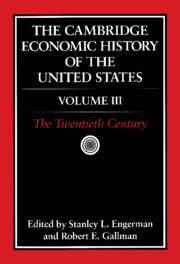Book contents
- Frontmatter
- 1 American Macroeconomic Growth in the Era of Knowledge-Based Progress: The Long-Run Perspective
- 2 Structural Changes: Regional and Urban
- 3 Twentieth-Century Canadian Economic History
- 4 The Twentieth-Century Record of Inequality and Poverty in the United States
- 5 The Great Depression
- 6 War and the American Economy in the Twentieth Century
- 7 U.S. Foreign Trade and Trade Policy in the Twentieth Century
- 8 U.S. Foreign Financial Relations in the Twentieth Century
- 9 Twentieth-Century American Population Growth
- 10 Labor Markets in the Twentieth Century
- 11 Labor Law
- 12 The Transformation of Northern Agriculture, 1910–1990
- 13 Banking and Finance in the Twentieth Century
- 14 Twentieth-Century Technological Change
- 15 The U.S. Corporate Economy in the Twentieth Century
- 16 Government Regulation of Business
- 17 The Public Sector
- Bibliographic Essays
- Index
- References
1 - American Macroeconomic Growth in the Era of Knowledge-Based Progress: The Long-Run Perspective
Published online by Cambridge University Press: 28 March 2008
- Frontmatter
- 1 American Macroeconomic Growth in the Era of Knowledge-Based Progress: The Long-Run Perspective
- 2 Structural Changes: Regional and Urban
- 3 Twentieth-Century Canadian Economic History
- 4 The Twentieth-Century Record of Inequality and Poverty in the United States
- 5 The Great Depression
- 6 War and the American Economy in the Twentieth Century
- 7 U.S. Foreign Trade and Trade Policy in the Twentieth Century
- 8 U.S. Foreign Financial Relations in the Twentieth Century
- 9 Twentieth-Century American Population Growth
- 10 Labor Markets in the Twentieth Century
- 11 Labor Law
- 12 The Transformation of Northern Agriculture, 1910–1990
- 13 Banking and Finance in the Twentieth Century
- 14 Twentieth-Century Technological Change
- 15 The U.S. Corporate Economy in the Twentieth Century
- 16 Government Regulation of Business
- 17 The Public Sector
- Bibliographic Essays
- Index
- References
Summary
OVERVIEW AND ORGANIZATION OF THE CHAPTER
This chapter focuses on the nature of the macroeconomic growth process that has characterized the United States experience, and manifested itself in the changing pace and sources of the rise of real output per capita in the U.S. economy during the past two hundred years. Our main interest is, indeed, in the twentieth century, but we believe that its major characteristics and the nature of the underlying forces at work are most clearly seen in comparisons between the century just past and the one that came before.
A key observation that emerges from the long-term quantitative economic record is that the proximate sources of increases in real gross domestic product per capita in the century between 1889 and 1989 were quite different from those which obtained during the first one hundred years of the American national experience. Baldly put, the national ecomomy moved from an extensive to an increasingly intensive mode of growth, and its development at the intensive margin has become more and more dependent upon the acquisition and exploitation of technological and organizational knowledge.
Our first objective, therefore, must be to assemble and describe the components of the U.S. macroeconomic record in some quantitative detail, in a manner that exposes the nature and dimensions of the contrast between the nineteenth and twentieth centuries. We approach this task within the well-established framework of “growth accounting.” This enables us to show the secular acceleration that occurred in the growth rate of total factor productivity, which is the weighted average of the productivities of capital and labor, and the growth in the importance of total factor productivity as a source of labor productivity and per capita output increases.
- Type
- Chapter
- Information
- The Cambridge Economic History of the United States , pp. 1 - 92Publisher: Cambridge University PressPrint publication year: 2000
References
- 30
- Cited by



